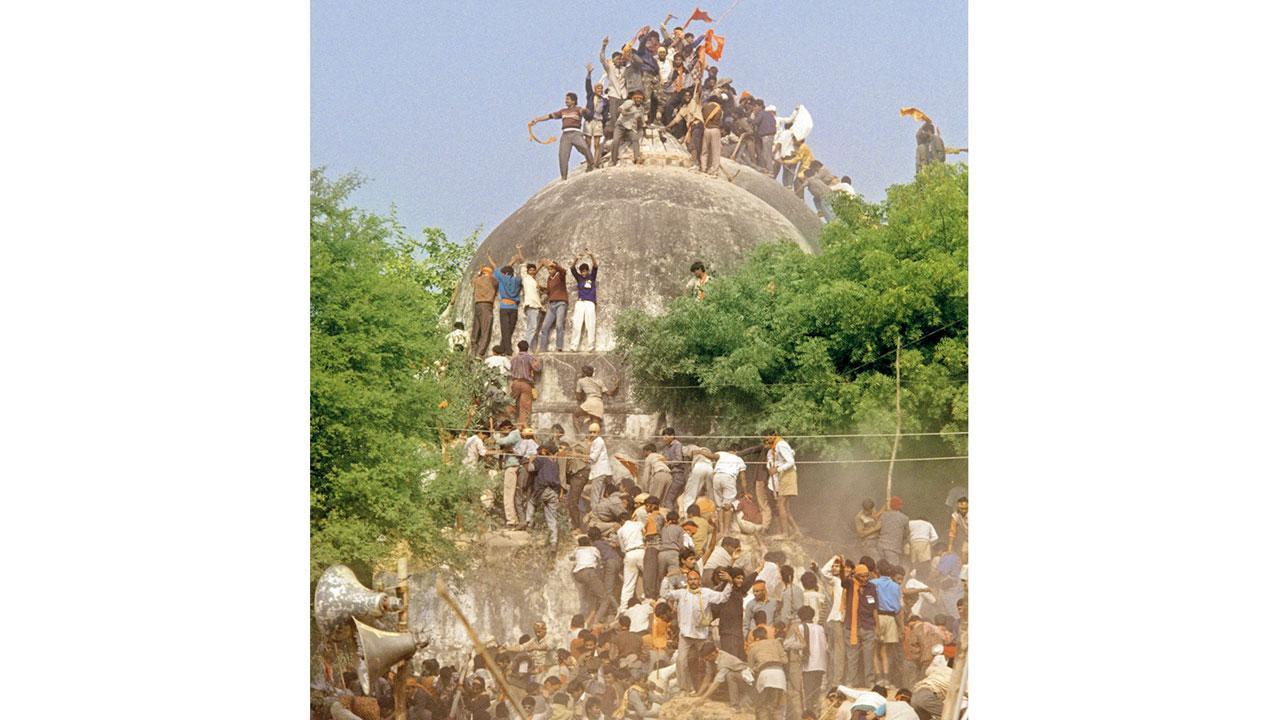Tomorrow is the 30th anniversary of the Babri Masjid demolition. The Hindutva brigade is furthering their insidious design by targetting more and more mosques. It really is scary to be a Muslim in this India

Every judicial pronouncement in the Ayodhya dispute expanded the rights of Hindus over the Babri Masjid. File pic
 I called S M Yaseen to ask about the meaning he read in the 30th anniversary of the demolition of the Babri Masjid, which falls tomorrow, December 6. After remaining silent long enough for me to think the call had dropped, Yaseen said, “The way things are, we will have more such anniversaries in the future.” Yaseen is the joint secretary of the Anjuman Intezamia Masajid, which is responsible for the upkeep of the Gyanvapi masjid in Varanasi.
I called S M Yaseen to ask about the meaning he read in the 30th anniversary of the demolition of the Babri Masjid, which falls tomorrow, December 6. After remaining silent long enough for me to think the call had dropped, Yaseen said, “The way things are, we will have more such anniversaries in the future.” Yaseen is the joint secretary of the Anjuman Intezamia Masajid, which is responsible for the upkeep of the Gyanvapi masjid in Varanasi.
ADVERTISEMENT
Besieged by as many as 18 lawsuits, the defence of Gyanvapi’s Islamic identity weakened earlier this year with the Supreme Court ruling, in effect, that a survey of its complex, controversially claiming a fountain in the ablution pool to be a Shivling, was not in violation of the Places of Worship Act, 1991. This Act freezes the religious character of a place of worship as it was on August 15, 1947.
The Supreme Court’s logic was that the Act does not debar ascertaining the religious character of a place of worship. It only proscribes turning, say, a mosque into a temple. The survey of the Gyanvapi masjid was ordered by a Varanasi civil court, acting on a petition filed by five women pleading that they be allowed to worship Maa Shringar Gauri and other deities supposedly present there. These women are not historians or archaeologists curious about the religious provenance of a structure. They wish to pray there, in a bid to appropriate the mosque for Hindus.
Also Read: Planning crucial before setting up night bazaars
The ascertainment process will create a tide of opinion for usurping the Gyanvapi mosque, as had happened with the Babri Masjid site that was ultimately handed over, through a 2019 Supreme Court judgment, to the Hindus.
True, the Act does not explicitly debar ascertaining the religious character of a place of worship. But then, the Constitution also does not provide for the collegium system for selecting judges. Yet the Supreme Court has been impressively assertive in protecting its turf from executive encroachments. Could it not have shown the same enthusiasm for protecting Gyanvapi from the insidious designs of the Hindutva brigade?
This question assumes importance in the backdrop of several masjid-mandir disputes simmering countrywide. A Mathura court has already ruled that petitions seeking the removal of the Shahi Eidgah mosque from the Krishna Janmabhoomi site do not fall within the ambit of the Places of Worship Act. There are litigations pertaining to the religious character of the Shamsi Jama masjid in Badaun, Uttar Pradesh, as well. Such mosque-temple disputes include Bhagyalakshmi-Charminar in Hyderabad, Baba Budangiri-Guru Dattatreya shrine in Karnataka, and the Bhojshala-Kamal Maula Mosque in Madhya Pradesh. Hindutva acolytes, anyway, claim that Muslim rulers destroyed 3,000 temples to build mosques in their place.
But now even the Places of Worship Act has been challenged in the Supreme Court, which will begin hearing the case next month. Muslims like Yaseen worry because they have seen every judicial pronouncement in the Ayodhya dispute expand the rights of Hindus over the Babri Masjid. In case the Act is struck down, 3,000 new reasons will be found to target 3,000 mosques.
The Rashtriya Swayamsevak Sangh and its affiliates are able to mobilise people on masjid-mandir disputes because of the myths spawned by school textbooks—the only history most Indians read in their lives. These textbooks sought to give cultural roots to the passive resistance against the British colonial rule, building upon the efforts of national movement stalwarts, Gandhi and Nehru included, to construct a past in which India was depicted to have been the abode of nonviolence before the advent of Muslims.
The foremost among these myths was that Buddhism disappeared from India because it was absorbed, through debates and accommodations, into Hinduism. None of our school textbooks detail how Pushyamitra Shunga, in 185 BCE, overthrew the Buddhist Mauryan dynasty, destroyed the Kukkutarama monastery in Pataliputra, vandalised the Sanchi stupa, and killed Buddhist monks wantonly. The genocidal violence against the Buddhists continued through the centuries, described vividly in Giovanni Verardi’s Hardships and Downfall of Buddhism in India.
Hindu rulers attacked temples long before Muslims made India their home. Victorious Hindu kings would plunder the temples their vanquished opponents patronised, ferret away the deities installed there and, in some cases, even break them. As early as 642 CE, the Pallava ruler Narasimhavarman I defeated the Chalukyas, sacked their capital Vatapi, and brought the idol of Ganesha to his kingdom in Tamil Nadu. In the early 10th century, the Rashtrakuta king Indra III destroyed the temple of Kalapriya, which the Pratiharas patronised. For more such instances, read Richard H David’s essay Indian Art Objects as Loot.
A history sanitised of Hindu violence ingrains a sense of exceptionalism among Hindus, as is likely true of that teacher of the Manipal Institute of Technology who called a Muslim student Kasab, the terrorist hanged for the 26/11 Mumbai massacre. The student riposted, “Being a Muslim and facing this every day in this country is not funny.” What the student did not explicitly say constitutes the meaning of the 30th anniversary of the demolition of the Babri Masjid—that it is grim and scary to be a Muslim in today’s India.
The writer is a senior journalist.
Send your feedback to mailbag@mid-day.com
The views expressed in this column are the individual’s and don’t represent those of the paper.
 Subscribe today by clicking the link and stay updated with the latest news!" Click here!
Subscribe today by clicking the link and stay updated with the latest news!" Click here!







